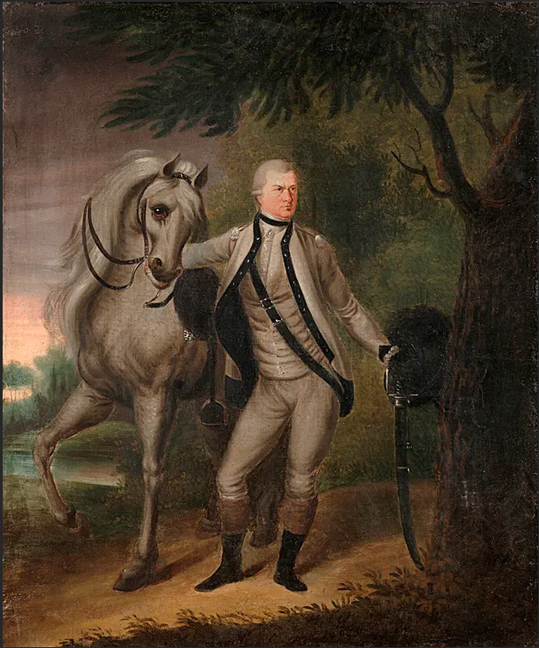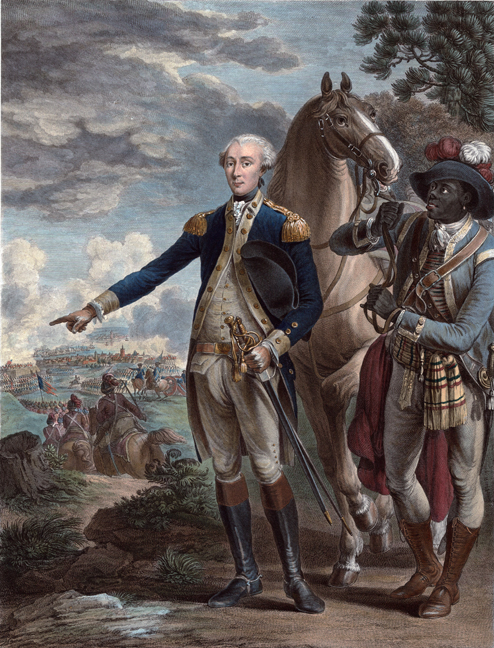
Questions about the validity of the Molly Pitcher legend bring up a broader gap in our understanding of military affairs during the era of the American Revolution: we have anecdotal evidence that soldiers’ wives were sometimes on the battlefield, but we don’t really know if this was common or rare, accepted or anomalous, sanctioned or surreptitious. Joseph Plumb Martin’s popular mention of a woman assisting a cannon crew focuses on the cannonball passing between her legs as being remarkable, rather than her very presence being noteworthy.[1] Although a British officer noted that hostile fire had “killed and wounded about 20 Soldiers and a Woman a Grenadiers Wife,” he provided no details on the specific circumstances.[2] References such as these are rare and leave us not knowing whether such events themselves were rare, or were so commonplace that they didn’t get mentioned. It is well-known that army wives were an integral part of army infrastructure in the roles of nurses, sutlers and washer women, but their place on the day of battle is little known.
There is a case of a soldier’s wife playing a role in a battle that has been largely overlooked in the lore of the Revolution. Perhaps it is because the battle itself is little-known that the event hasn’t been widely related; perhaps it is because she was the wife of a British soldier that this brave woman has not been hailed as a hero. The event took place at the Battle of Trois-Rivières (Three Rivers) on 8 June 1776, part of the rout of American forces that had attempted to seize Canada from British control the previous year. Soon after the battle a British officer wrote about it in a letter to his patron in Great Britain, closing with these remarkable paragraphs:
I must not omit telling your Lordship of one Instance of Courage that was shown at Trois Rivieres by a fair Country woman of ours, that deserves to be recorded. The wife of Middleton Soldier in the 47th Regt. quite alone took & disarmed six Provincial Soldiers, & was the means of two more being taken also. The Circumstances are thus, which [she] related to Genl. Burgoyne in my Presence. She said she went to a House about a quarter of a Mile from the River near the Wood, for some Milk to carry to her Husband the 8th of June during the Engagemt. That on opening the Door she saw six Rebel Soldiers armed, that this daunted her a little, however she took Courage, & rated them saying, “Ay’nt ye ashamed of yourselves ye villains to be fighting agst. your King & Countrymen” that they looked sheepish, therefore she said, you are all Prisoners give me your Arms, that two more remained at the Outside of the back Door, which she was more afraid of than all the rest, that however standing between them, & their Arms, she called to some Sailors at the River Side, to whom she delivered the Prisoners, & who presently took the other two.
This is exactly true, & she is, contrary to what you wou’d imagine her, a very modest, decent well looking Woman.[3]
We’ve found no other account substantiating Mrs. Middleton’s feat, but given the closeness of the account to the actual event there is no reason to doubt its veracity. A Robert Middleton was in the ranks of the 47th Regiment at this time and had a long career in the army;[4] unfortunately there are no surviving records showing which British soldiers were married, and at this writing no other specific reference to Mrs. Middleton has been found – not even her first name. Sadly, hers is a common case, as references to individuals among the several thousand British army wives in America are extremely rare.
Noteworthy in this record of Mrs. Middleton’s feat is that it doesn’t suggest her very presence as remarkable; that she was seeking refreshment for her husband seems to be mentioned strictly to provide context for the important aspects of the story. This lends credence to the notion that the women water-bearers of popular lore were not unusual even though primary sources seldom mention them. More information is needed before we can draw conclusions.
Regardless of prevalence, there is an interesting irony to the tales of women on the battlefields of the American Revolution: Molly Pitcher, who probably never existed, has become a cornerstone of the war’s history, while Mrs. Middleton, whose bravery is clearly documented, has been forgotten.
[1] Martin wrote: “A woman whose husband belonged to the artillery and who was then attached to a piece in the engagement, attended with her husband at the piece for the whole time. While in the act of reaching a cartridge and having one of her feet as far before the other as she could step, a cannon shot from the enemy passed directly between her legs without doing any other damage than carrying away all the lower part of her petticoat. Looking at it with apparent unconcern, she observed that it was lucky It did not pass a little higher, for in that case it might have carried away something else, and continued her occupation” Joseph Plumb Martin, Ordinary Courage: The Revolutionary War Adventures of Joseph Plumb Martin (Chichester, England: John Wiley & Sons, 2013) 88.
[2] This occurred in New Jersey on June 22, 1777 in a skirmish that began “where the Quibbletown Road meets and turns into the Amboy Road.” “Journal of the Operations of the American Army under General Sir William Howe from the Evacuation of Boston to the end of the Campaign of 1776” (this document also includes a journal of operations in New Jersey, June 11 – July 31, 1777). British Library, Egerton Manuscripts.
[3] “Letters to Lord Polwarth from Sir Francis-Carr Clerke, Aide-de-Camp to General John Burgoyne,” New York History, 79, #4 (October 1998), p. 413.
[4] Robert Middleton was born in Carlow, Ireland around 1736. He was already in the 47th Regiment when that corps arrived in America in 1773, and transferred into the 8th Regiment of Foot in 1782. He later served in the Carlow Militia, and received a military pension in 1800 at the age of 66 after 35 years and 10 months of service (not necessarily continuous). Muster rolls, 47th Regiment of Foot, WO 12/5871; discharge of Robert Middleton, WO 121/149/63; both in The National Archives, Kew, England.








6 Comments
The Hessian Jager, Johann Ewald, included some ‘Remarks concerning the army’s baggage’ in his diary. He added the section out of amazement that Lord Cornwallis would be so indulgent of his men. “Every officer had four to six horses and three or four Negroes, as well as one or two Negresses for cook and maid. Every soldier’s woman was mounted and also had a Negro and Negress on horseback for her servants.”
I noticed that Ewald seemed amazed at all the slaves included in the camp followers but hardly surprised that every soldier had a woman with him. 🙂
This is a great passage, Wayne. It is important to note that Ewald joined up with Cornwallis’ army in Virginia in June 1781, after the famous rapid campaign through the Carolinas; the baggage train described by Ewald may not have been typical of the entire campaign. Also notice that Ewald doesn’t say “every soldier had a woman with him”, but every soldier’s woman who was present (usually only a few per company on campaign) had servants – a lot of people, but not nearly as many as if every soldier had had a woman with him.
Ewald’s passage doesn’t indicate where all of these women and servants went when bullets started flying. Earlier in the year, on 30 January 1781, the Brigade of Guards in Cornwallis’s army had been given the enigmatic order, “When the Brigade Marches the Women, Sick, & Weakly Men, will March in the Rear of the Second Battn & in Case the Brigade Shoud be ordered forward – and they cant keep up – they will form a Guard to the Baggage, Packs, or what else May be left in their Charge.” This suggests that the women were expected to take an active role in guarding the baggage, but there is room for interpretation.
Interesting reference to Cornwallis in late January 1781. At that point, Cornwallis had just completed his famous burning of the wagons to lighten the load and chase Morgan/Greene across North Carolina. Even though they felt the need for speed, there is really nothing that can be done with the women and walking wounded but bring them along.
Yet another reference to women with the British on the southern campaign comes from King’s Mountain. Patrick Ferguson’s servant (or lady friend perhaps) Virginia Sal is buried with him in the grave at King’s Mountain. Yet the battlefield losses reported in great detail in the Rivington Gazette do not mention her. “We lost eighteen men killed on the spot – Capt. Ryerson and thirty-two Sergeants and privates wounded of Maj. Ferguson’s detachment, Lieutenant McGinnis of Allen’s regiment, Skinner’s brigade, killed; taken prisoner; two Captains, four lieutenants, three Ensigns, One Surgeon, and fifty-four Sergeants and privates, including the wounded, wagoners, etc. The miltia killed, one hundred, includind officers; wounded, ninety; taken prisoners about six hundred; our baggage all taken, of course.”
Somewhere in that description, Virginia Sal died too. 🙂
I read this story a bit differently. Did the soldiers surrender simply because Mrs. Middleton had scolded them, saying they should be ashamed of themselves? That is the British reading: rebels were acting childishly and needed go be reprimanded. This, I believe, is why the story was told to Burgoyne and passed on within British circles. But is it plausible to think that these men would submit themselves to the horrors of a British prison ship because having been scolded by Mrs. MIddleton, they suddenly realized they were wrong? More likely, they looked “sheepish” and surrendered their arms and themselves because they had been discovered within British held territory — note that Mrs. Middleton called for nearby sailors to finish the arrest. What else could the men do? Run over Mrs. Middleton and try to escape, likely sealing their fates? In this context, I don’t see this as a particular act of bravery but as a morality tale told by British to British, affirming their image of rebels as bad boys who just needed to be scolded to set them straight. In some sense, this is the mirror image of the Nancy Hart story told by patriots, but in that story, Nancy Hart didn’t have friendly sailors or soldiers within calling distance to help her out.
Yes, this story reminded me very much of the legend of Nancy Hart, supposedly six feet tall and cross-eyed. As the story goes, Nancy turned the tables on Tory intruders in her home, captured them with the help of her daughter, then turned them over to patriots to be hanged. And now she has a county in Georgia named after her. 🙂
Both sides have this anecdote. I suspect it was a way to thumb your nose at the enemy. “Nyah, nyah, some soldier you are. You got captured and disarmed by a woman.”
Mrs Middleton Takes Prisoners:
Another great story, Don! The other comments are spot-on as well. It makes a nice summary of women’s duties during the A.W.I. But there’s still more to learn.
Over the years I’ve jealously hoarded one special anecdote about women’s role on the battlefield, and this seems like a good place to finally air it out and share it. It reinforces the traditional theory of woman as water-fetcher.
First the background. John Markland was a New Yorker who saw service with Colonel Lasher’s regiment of uniformed New-York City Militia in 1775 and 1776, then accepted a commission in the 6th Pennsylvania Regiment in 1777. He was barely 22 at the time of Brandywine.
Ensign Markland served in Captain Jacob Bower’s Company of Lt. Colonel Henry Bicker’s 6th Pennsylvania Regiment, which was itself part of Brigadier General Thomas Conway’s 3rd PA Brigade on 11 September 1777 during the Battle of Brandywine.
With that necessary organizational distraction out of the way, here’s the story, as prepared by Markland and friends as part of a competitive political advertisement in 1826:
“He was in Conway’s Brigade, and most of the day engaged in action, – in the morning near Chad’s Ford, and in the afternoon near Birmingham Meeting-House. Late in the afternoon the American army drew off from the field of battle, leaving the British army in no hurry to follow them. Before dismissing the subject of the battle it may prove interesting to relate an anecdote of an occurrence which exhibited a noble trait in the female character, showing devotion to their cause and fearless attention to the defenders of their rights. While the battle was raging near Birmingham Meeting-House the wives of several of the soldiers belonging to the Sixth Pennsylvania Regiment, with which Markland was then serving, took empty canteens of their husbands and friends and returning with them filled with water, which they persisted in delivering to the owners during the hottest part of the engagement, although frequently cautioned as to the danger of coming into the line of fire.”
Pennsylvania Magazine of History & Biography 9 (1885):102-112.
Ironically, Markland does not discuss the battle at all!
It seems most likely to me that as the Pensylvanians marched from Chads’ Ford to take up new positions near Birmingham Meeting-House, their canteens were already emptied during the earlier fighting. So the women ran a water detail before the onset of the anticipated new struggle. On their return, the fight had already started. Now the battle station during combat for an ensign in a company of infantry was commonly prescribed on the far left edge, or to the immediate rear, so Ensign Markland would have had a good view of the proceedings. The women came right up the their menfolk with bullets flying and delivered full canteens. It is not clear if the men were standing entirely in the open or under some partial cover.
What is interesting is that their men clearly did not want them there (even though the water was probably appreciated), and said so repeatedly.
A dead wife wife is of no practical use to her loved ones, and a wounded wife cannot possibly be cared for by a soldier in the midst of a campaign. Hospital staff would be overwhelmed by the need to attend to the soldiers first. The men of the 6th Pennsylvania were veteran enough to understand the dangers of unsympathetic bullets flying through “the line of fire”. Unpaid camp followers would receive low priority by the exhausted doctors after a large action.
I take from this and your other anecdotes as proof that water-fetching was a key duty for a woman, but she was not (unlike the soldiers) expected to lay down her life for her country. When some of them risked just that, it caught the attention of participants and burned into their memories.
Many narratives reveal that women of both sides got caught up in fighting situations (usually defensive in nature), but I’ve never yet seen an account in which they seek out or approach a known danger in the same manner as the girls with the 6th Pennsylvania.
I only wish that John Markland had taken additional time in 1826 to flesh out in glorious detail the rest of his wartime service for his descendants and for the curious among us today.
Stephen Gilbert